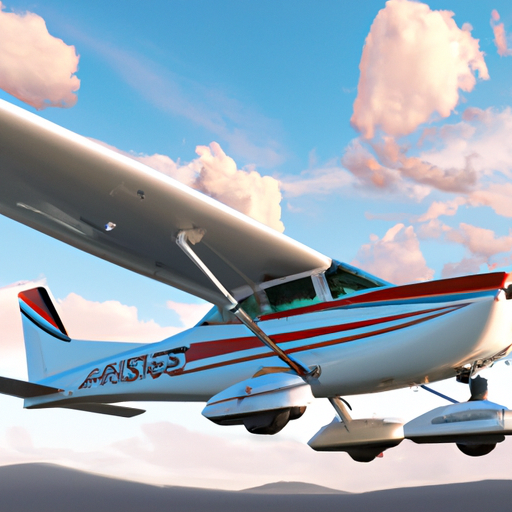
Have you ever wondered what it would be like to fly in a small plane? Maybe you’ve even dreamed of being a pilot yourself one day. Well, let me introduce you to the Cessna 207, a popular aircraft that will surely pique your interest. In this article, we will dive into the details of the Cessna 207 and explore its features further. Brace yourself for an exciting journey as we take a closer look at this remarkable aircraft!
The Cessna 207 is a versatile and reliable aircraft that has captured the attention of aviation enthusiasts worldwide. With its sleek design and powerful engine, this plane offers a smooth and enjoyable flying experience. From its spacious cabin that can accommodate up to seven passengers to its impressive range that allows for long-distance travel, the Cessna 207 proves to be a reliable choice for various purposes. Whether you’re looking to embark on a scenic family holiday or transporting goods to remote locations, this aircraft is up for the challenge. So, if you’re curious about learning more about the Cessna 207 and how it can enhance your flying experience, keep reading our article for a more comprehensive overview.

Overview
Introduction to the Cessna 207
The Cessna 207, also known as the Cessna Stationair 7, is a single-engine, high-wing aircraft manufactured by Cessna Aircraft Company. It is a versatile and reliable aircraft that has become popular for various uses, including commercial operations, aerial surveying and mapping, and recreational flying. With its unique design and range of features, the Cessna 207 has made a significant impact in the aviation industry. In this article, we will explore the design, history, uses, advantages, maintenance considerations, notable variants, industry impact, and future prospects of the Cessna 207.
Design and Specifications
Exterior design and features
The Cessna 207 features a sleek and aerodynamic exterior design, with a high-wing configuration that provides stability and improved visibility. Its sturdy construction and robust landing gear allow it to operate on various types of terrain, including unpaved runways. The aircraft is equipped with durable metal wings, which contribute to its overall durability and performance. Additionally, the Cessna 207 offers ample storage space, making it suitable for carrying cargo.
Interior design and amenities
Inside the Cessna 207, you will find a comfortable and spacious cabin that can accommodate up to six passengers. The cabin is designed with ergonomics in mind, ensuring that passengers have sufficient legroom and headspace. The seats are upholstered with high-quality materials, providing a comfortable experience during flights. The large windows and panoramic views allow passengers to enjoy the scenery while traveling. Furthermore, the Cessna 207 is equipped with modern avionics and navigation systems, enhancing the pilot’s capabilities during flights.
Engine and performance specifications
The Cessna 207 is powered by a single Continental Motors IO-520-F engine, delivering a maximum horsepower of 285. This engine provides sufficient power to propel the aircraft at a maximum cruise speed of approximately 175 knots, with a range of around 700 nautical miles. The Cessna 207 has a maximum takeoff weight of 3,800 pounds and a maximum payload capacity of 1,297 pounds. These specifications allow the aircraft to operate efficiently in various conditions, including short and unimproved runways.
History and Development
Origins and purpose
The Cessna 207 was developed by Cessna Aircraft Company as a successor to the popular Cessna 206. It was designed to meet the growing demand for a versatile and reliable aircraft that could be used for various purposes. The Cessna 207 was intended to cater to both commercial and private operators, offering enhanced performance and capabilities compared to its predecessor. With its larger cabin and increased payload capacity, the Cessna 207 became a preferred choice for many businesses and individuals.
Evolution of the Cessna 207
Since its initial introduction, the Cessna 207 has undergone several notable developments and improvements. These advancements have focused on enhancing the aircraft’s performance, safety features, and overall user experience. Over the years, Cessna has incorporated technological innovations and customer feedback into the design of the Cessna 207, making it a reliable and efficient aircraft for various applications.

Uses and Applications
Commercial use of the Cessna 207
The Cessna 207 has found extensive use in commercial operations, such as air taxi services, charter flights, and cargo transportation. Its ability to operate on short runways and varying terrains makes it a popular choice for businesses operating in remote or challenging locations. The aircraft’s spacious cabin and payload capacity enable operators to transport passengers and cargo efficiently, making it a valuable asset in the commercial aviation industry.
Aerial surveying and mapping
With its excellent maneuverability and stability, the Cessna 207 is a preferred aircraft for aerial surveying and mapping missions. Equipped with specialized camera systems and sensors, the aircraft can capture high-resolution imagery and collect accurate data for various applications, including environmental monitoring, infrastructure assessment, and urban planning. The Cessna 207’s versatility in adapting to different surveying equipment makes it a reliable platform for professional mapping and surveying organizations.
Recreational and private use
The Cessna 207’s versatility extends to recreational and private use, appealing to individuals who enjoy flying for leisure or personal travel. Its spacious cabin and comfortable seating make it ideal for family trips or weekend getaways. The aircraft’s range allows pilots to explore multiple destinations within a single flight, providing the freedom and convenience desired by private aircraft owners. Whether it’s a scenic flight or an adventure in remote locations, the Cessna 207 offers an enjoyable flying experience for recreational and private users.
Advantages and Features
Versatility and adaptability
One of the key advantages of the Cessna 207 is its versatility and adaptability for various applications. Whether it’s commercial operations, aerial surveying, or private use, the aircraft can easily accommodate different requirements. Its ability to operate on short runways and unpaved surfaces expands its accessibility and operational range, making it suitable for a wide range of environments. The Cessna 207’s adaptability is further enhanced by its spacious cabin and payload capacity, which allows for customized interior configurations and efficient transportation of passengers or cargo.
Safety and reliability
Cessna Aircraft Company has a long-standing reputation for producing safe and reliable aircraft, and the Cessna 207 is no exception. The aircraft is built with high-quality materials and undergoes rigorous testing to ensure it meets the highest standards of safety. The Cessna 207 incorporates advanced avionics and navigation systems, providing pilots with real-time situational awareness and enhancing the overall safety of each flight. Additionally, the aircraft’s sturdy construction and robust landing gear contribute to its reliability and capability to operate in diverse conditions.
Comfort and convenience
The Cessna 207 prioritizes passenger comfort and convenience. The cabin is designed to provide ample legroom and headspace, ensuring that passengers can relax and enjoy their journey. The large windows and panoramic views allow for breathtaking scenery during flights, providing an added level of enjoyment for both passengers and pilots. The aircraft’s modern avionics and navigation systems enhance the pilot’s capabilities, making each flight smooth and efficient. Furthermore, the spacious cabin and payload capacity enable operators to transport cargo or luggage without compromising passenger comfort.
Maintenance and Operational Considerations
Regular maintenance requirements
To ensure the continued safety and performance of the Cessna 207, regular maintenance is crucial. Routine inspections, engine checks, and system updates are necessary to maintain the aircraft’s airworthiness. Service intervals and maintenance requirements are outlined in the manufacturer’s maintenance manual and should be followed diligently. Additionally, proper storage and regular cleaning contribute to the longevity of the aircraft and its components.
Operating costs and efficiency
When considering the Cessna 207 for commercial or private use, it is essential to assess the operating costs and efficiency. Fuel consumption, maintenance expenses, and insurance are factors that need to be considered. The Cessna 207’s fuel efficiency, adaptable performance, and durability contribute to its overall cost-effectiveness. Operators can optimize its use, ensuring that each flight is efficient while adhering to safety regulations.
Pilot training and certification
To operate the Cessna 207, pilots must undergo proper training and acquire the necessary certifications. Flight schools and training centers offer courses specifically designed for this aircraft, covering its unique systems and flight characteristics. Pilots should familiarize themselves with the aircraft’s flight manual, which provides guidance on its operation and limitations. By obtaining the relevant training and certification, pilots can confidently and safely operate the Cessna 207.
Notable Variants
Unique models and adaptations
Over the years, various unique models and adaptations of the Cessna 207 have been developed to cater to specific needs and requirements. Some variants may feature modifications to enhance performance, such as upgraded engines or avionics systems. Others may have specialized equipment installed for specific missions, such as aerial photography or medical evacuation. These adaptations highlight the versatility of the Cessna 207 and its ability to accommodate diverse applications within the aviation industry.
Specialized configurations
In addition to unique models, the Cessna 207 offers specialized configurations to cater to specific operational demands. These configurations may include modifications to the interior layout, such as cargo compartments or additional seating options. Additionally, operators may equip the aircraft with external camera mounts or sensor pods for aerial surveying and mapping missions. These specialized configurations further enhance the flexibility and adaptability of the Cessna 207 for different uses.
Industry Impact and Reception
Role in aviation industry
The Cessna 207 has played a significant role in the aviation industry, providing a reliable and versatile aircraft for various applications. It has become a preferred choice for commercial operators, thanks to its combination of performance, payload capacity, and durability. Aerial surveying and mapping organizations rely on the Cessna 207 for its stability and maneuverability, enabling accurate data collection and analysis. In the private and recreational sector, the aircraft’s comfort, range, and adaptability have made it a popular choice among flying enthusiasts and individuals seeking convenient transportation.
User feedback and reviews
The Cessna 207 has received positive user feedback and reviews, reflecting its performance and reliability. Operators appreciate its versatility and adaptability, noting its ability to operate in diverse conditions. Pilots praise its comfortable cabin and modern avionics, enhancing the overall flying experience. Passengers enjoy the spaciousness and panoramic views, making each flight enjoyable and memorable. Overall, the Cessna 207 has gained a favorable reputation among users in various sectors of the aviation industry.
Popularity and demand
The Cessna 207 continues to be in high demand within the aviation industry due to its unique features and capabilities. The aircraft’s versatility and adaptability make it suitable for a wide range of uses, ensuring its continued popularity among operators and individuals alike. The Cessna 207’s reputation for safety, reliability, and performance contributes to its strong demand and its position as a preferred choice in the market.
Future Prospects and Developments
Potential upgrades and advancements
With advancements in technology and evolving industry needs, the Cessna 207 is likely to undergo future upgrades and advancements. These upgrades may include improved avionics systems, more fuel-efficient engines, and enhanced aerodynamics. The continuous development of new materials and manufacturing techniques may also contribute to further improvements in the aircraft’s performance and durability. Additionally, advancements in data collection and analysis technologies may lead to more sophisticated aerial surveying and mapping capabilities.
Market trends and predictions
The market for aircraft like the Cessna 207 is expected to grow in the coming years. The demand for versatile and adaptable aircraft that can cater to various industry needs is projected to increase. This growth is driven by factors such as expanding commercial operations, the need for accurate data collection, and the desire for convenient and comfortable private travel. Manufacturers will continue to innovate and improve their offerings to meet these demands, ensuring the Cessna 207 remains competitive in the market.
Conclusion
In conclusion, the Cessna 207 is a versatile and reliable aircraft that has made a significant impact in the aviation industry. Its design, performance, and features make it suitable for various applications, including commercial operations, aerial surveying and mapping, and private use. The Cessna 207’s adaptability, safety, and comfort contribute to its popularity and positive reception among operators, pilots, and passengers. As the aviation industry evolves, the Cessna 207 is expected to continue meeting the demands of the market through upgrades and advancements. Whether it’s transporting passengers, capturing data, or providing a memorable flying experience, the Cessna 207 is a trusted and capable aircraft.



Leave a Reply